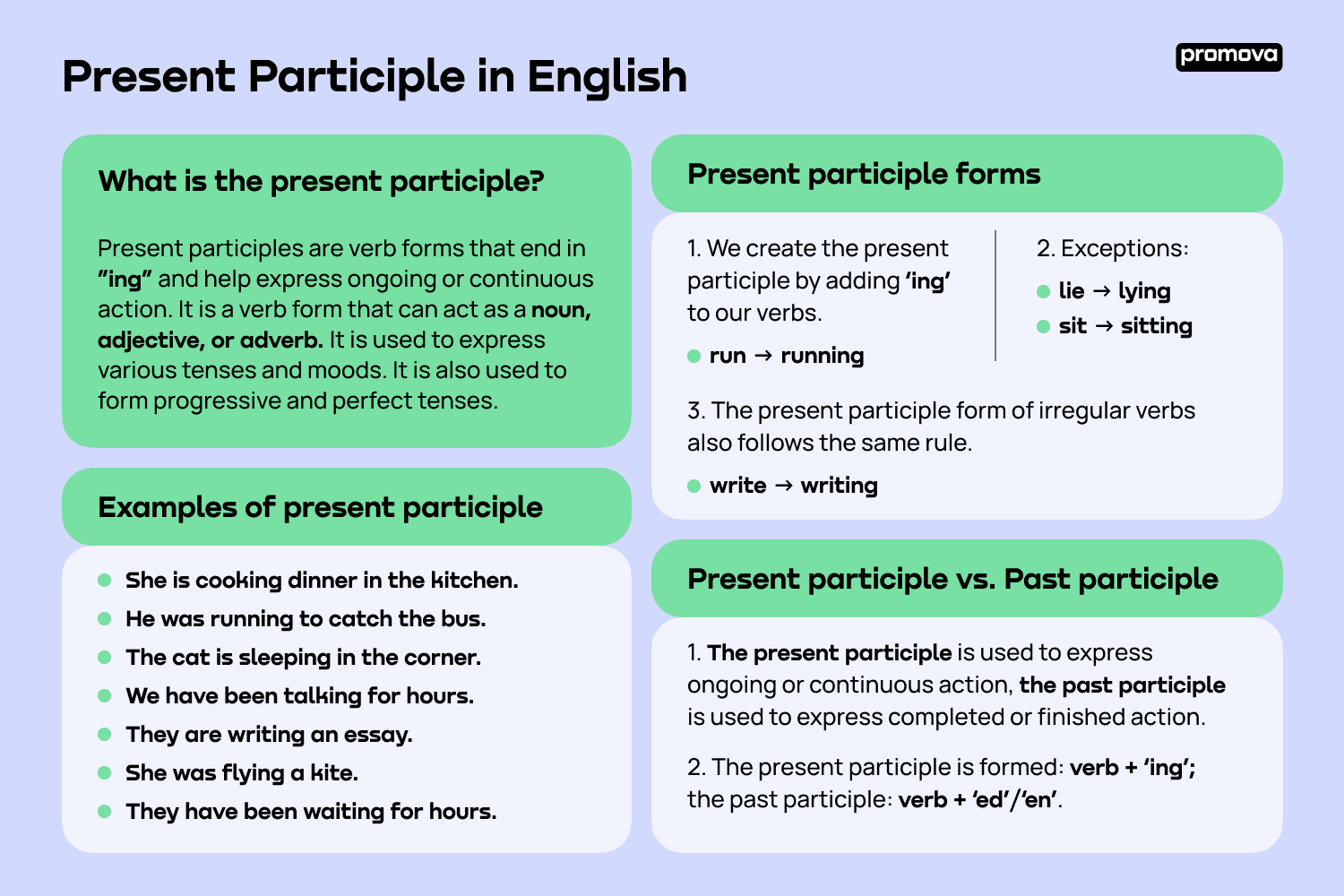Present Participle in English
Contents
In this reference, we will discuss everything related to the present participle in English, including its definition, examples, forms, common usage, differences with past participles, and tips to learn and use it effectively.
What is the Present Participle?
Present participles are verb forms that end in ‘ing’ and help express ongoing or continuous action. Also known as an -ing form, gerund, and verbal noun. It is a verb form that can act as a noun, adjective, or adverb.
For example, in the sentence “The students were singing in the school hall,” the verb “singing” is in the present participle form. Here, it acts as an adjective and describes the action of the students.
We form them by adding ‘ing’ to the base form of the verb. It is used to express various tenses and moods. It is also used to form progressive and perfect tenses. 
Examples of Present Participle
Examples of present participles in English.
- She is cooking dinner in the kitchen.
- He was running to catch the bus.
- The cat is sleeping in the corner.
- We have been talking for hours.
- They are writing an essay.
- She was flying a kite.
- They have been waiting for hours.
- He is walking in the park.
- I am reading a book.
- The birds were singing in the tree.
Present Participle Forms
We create the present participle by adding ‘ing’ to our verbs. For example, the base form of the verb ‘run’ is ‘run,’ and the present participle form of the verb ‘run’ is ‘running.’
However, there are some exceptions. For example, the base form of the verb ‘lie’ is ‘lie,’ and the present participle form of the verb ‘lie’ is ‘lying.’ Similarly, the base form of the verb ‘sit’ is ‘sit,’ and the present participle of the verb ‘sit’ is ‘sitting.’
Note that the present participle form of irregular verbs also follows the same rule. For example, the base form of the verb ‘write’ is ‘write,’ and the present participle form of the verb ‘write’ is ‘writing.’ Similarly, the base form of the verb ‘go’ is ‘go,’ and the present participle form of ‘go’ is ‘going.’
Common Usage of Present Participles
Present participles are used in various ways in the English language. Here are some ways to use present participles.
- Present participles help form the present continuous tense. For example, “I am writing an essay.”
- Present participles help form the present perfect tense. For example, “I have been writing an essay.”
- Present participles help form the past continuous tense. For example, “I was writing an essay.”
- Present participles help form the past perfect tense. For example, “I had been writing an essay.”
- Present participles help form the future continuous tense. For example, “I will be writing an essay.”
- Present participles help create the future perfect tense. For example, “I will have been writing an essay.”
- Present participles are used as adjectives. For example, “The singing birds are beautiful.”
- Present participles are used as adverbs. For example, “He ran quickly.”
- Present participles are used in gerunds. For example, “I enjoy writing.”
- Present participles are used in verb phrases. For example, “He was talking to his friends.”
2
Present Participle vs. Past Participle
Present participle and past participle are two verb forms in English. While the present participle is used to express ongoing or continuous action, the past participle is used to express completed or finished action.
For example, in the sentence “I am writing a book,” the verb “writing” is in the present participle form and expresses ongoing or continuous action. In the sentence “I have written a book,” the verb “written” is in the past participle form and expresses completed or finished action.
Both present participle and past participle are formed in different ways. We already know that the present is just adding ‘ing’ to the base form of our verb. On the other hand, the past participle is formed by adding ‘ed’ or ‘en’ to the base form of the verb.
Learning Present Participle in English
Learning the present participle in English can seem daunting at first. However, with practice, it can become easy and even enjoyable!
Here are some ways to practice the present participle in English:
- Focus on understanding the concept of the present participle. Once you understand the concept, it will be easier to learn the different verb forms and how to use them.
- Read in English. This will help you become familiar with the different verb forms and how they are used in sentences.
- Practice writing sentences with present participles. You will become familiar with verb forms and how to use them.
- Use Promova practice tests to test your understanding of the present participle.
10 sentences with present participles
Here are ten more sentences with present participles.
- She is dancing gracefully.
- He is talking loudly.
- They are running quickly.
- I am writing a novel.
- He is playing the piano beautifully.
- We are eating dinner together.
- She is singing a lovely song.
- They are studying for their exams hard.
- He is reading a book silently in the corner of the room.
- She is painting a beautiful landscape on canvas.
Summary
The present participle in English is widely used to create continuous and perfect tenses, as well as gerunds. With practice and dedication, you can easily become familiar with the present participle and use it correctly in your sentences.
To learn more about the present participle in English, explore our website for more great lessons. Find more ways to improve your language skills below!
Comments